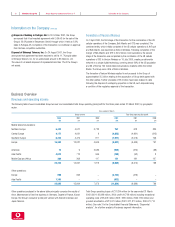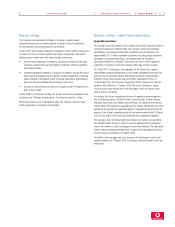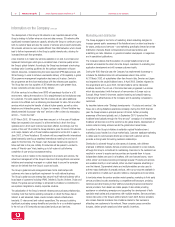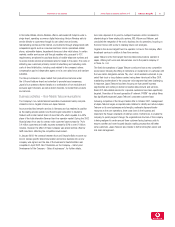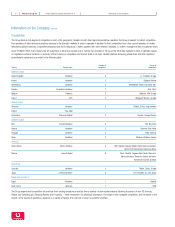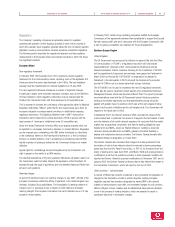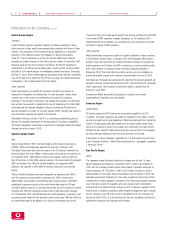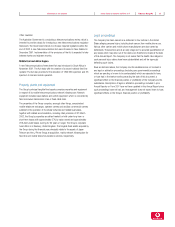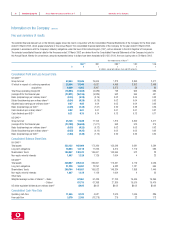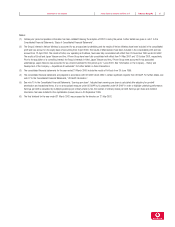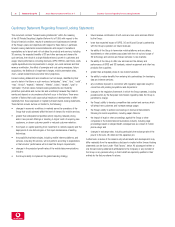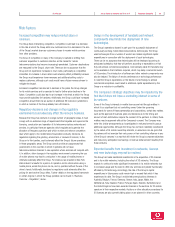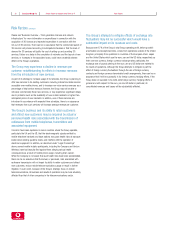Vodafone 2002 Annual Report Download - page 22
Download and view the complete annual report
Please find page 22 of the 2002 Vodafone annual report below. You can navigate through the pages in the report by either clicking on the pages listed below, or by using the keyword search tool below to find specific information within the annual report.
Vodafone Group Plc Annual Report & Accounts and Form 20-F Information on the Company20
The development of the Group’s 3G networks is an important element of the
Group’s strategy to further enhance voice and data revenue. 3G networks offer
significantly increased spectrum capacity, allowing the Group to continue to grow
both its customer base and also the volume of services and product functionality.
3G networks will also be more capital efficient than GSM networks, which should
lead to further improvements in the Group’s capital intensity ratio, allowing for
increased free cash flow generation.
A key objective is to make new services available on an end-to-end basis and
implement technologies which give a consistent level of service quality across
the Group’s global footprint. Accordingly, the Group has developed a technology
roadmap which is setting guidelines for the optimum deployment of future
network resources, complementing the newly launched GPRS data services with
3G technology. In order to achieve a successful delivery of 3G capability, a global
3G programme management organisation has been put in place. Central to
this programme are the close relationships with key infrastructure suppliers.
The Group has only four suppliers of 3G infrastructure to give greater focus,
reduce complexity and also ensure timely delivery.
All of the services to be offered over GPRS will seamlessly function in a 3G
environment, making the transition to 3G a straightforward and evolutionary step
for customers. The extra capacity that 3G provides will also allow additional
services to be offered such as streaming and download for video, film and other
services which require the transfer of data at higher speeds, as well as video
telephony and interactive gaming. In Japan, for example, J-Phone Vodafone has
already extended its popular “sha-mail”service to offer a video-clip messaging
service – “movie sha-mail”.
At 31 March 2002, 3G licences have been secured, or in the case of Vodafone
Ireland are expected to be secured, in all the territories in which the Group
operates and in which such licences have been offered. Accordingly, over the
course of the next 18 months the Group intends to open for service 3G networks
in its major markets, with J-Phone Vodafone expected to be the first to open in
June 2002. J-Phone Vodafone’s 3G network will be compatible with international
global standards, opening up seamless international roaming into and out of
Japan for the first time. The Group’s main European markets are expected to
follow suit later in the year. Initially, 3G networks will be opened to conduct a
series of “friendly-user”trials, leading up to full-scale roll-out following
completion of user product acceptance testing.
The Group’s work in relation to the development of products and services, the
rollout and management of the Group’s brand and other significant commercial
initiatives are increasingly managed on a global basis to secure the synergies
that can be derived from the Group’s scope and scale.
The Group’s global account management team forms relationships with
customers who have a significant requirement for multi-national business.
The Group’s global account strategy has secured multi-national business with a
broad base of customers including KPMG, Deloitte & Touche, Unilever, Chubb and
Henkel. The global account strategy is enhanced by Vodafone’s commitment to
use systems integrators to develop corporate solutions.
The globalisation of the Group’s network infrastructure purchasing relationships,
including more than twenty operating companies in which the Group has an
interest, is well advanced. Areas covered include network infrastructure,
handsets, IT, interconnect and indirect expenditure. This process is yielding
significant purchasing synergy benefits and provides for a co-ordinated approach
to the roll-out of 3G networks and associated products and services.
Marketing and distribution
The Group engages in two forms of marketing: brand marketing designed to
increase general public awareness of the Vodafone brand or other local brands –
its values, products and services – and marketing specifically directed at certain
distribution channels. Brand communications include sponsorships and
advertising on radio, television, in general circulation newspapers, in magazines
and in specialised publications.
The Company believes that the adoption of a single Vodafone brand in all
markets will maximise the return from the Group’s investment in marketing and
application development and will increase customer loyalty.
During the 2002 financial year, the Company has implemented its strategy to
introduce the Vodafone brand into all businesses where it has control.
At 31 March 2002, all subsidiaries other than those in Italy, Sweden and Japan
had migrated to the single Vodafone brand. In April 2002, Sweden migrated to
the single brand and in June 2002, Omnitel Vodafone will be rebranded
Vodafone Omnitel. The roll-out of the brand has been progressed in a manner
which also associates it with the launch of new services in Europe such as
Eurocall, Virtual Home Environment, assisted roaming and prepaid roaming,
enhancing the attractiveness of the Company and its operating companies to
customers.
As described above under “Strategic developments – Products and services”,the
Group ran a strong Vodafone awareness campaign. During the 2002 financial
year, the Group became a principal sponsor of Ferrari, further promoting
awareness of the brand globally, and, in September 2001, launched the
Vodafone brand globally through the ‘How are you?’ campaign. It is intended that
Vodafone will become one of the world’s top ten global brands. Development of
mobile content is being achieved under the global brand name Vizzavi.
In addition to the Group’s initiatives to establish a global Vodafone brand,
marketing is also handled on a local market basis. Customer database marketing
is widely used to communicate directly and, linked with customer service,
provides a strong basis for building customer relationships.
Distribution is achieved through a wide variety of channels, with different
emphasis in different markets. Service providers are prevalent in some markets,
although the Group’s commitment to maintaining close links to the customer has
resulted in a move to acquire service providers and operate them in-house.
Independent dealers are used in all markets, with own-branded stores, “store-
within-stores”and kiosks becoming increasingly popular. Products and services
are available directly in most markets, either via direct response advertising or
over the Internet. Supermarket chains and multiple retailers are also used to
achieve mass distribution of prepaid products, with top-up vouchers available in
a wide selection of outlets such as petrol stations, newsagents and local stores.
In territories where the service provider model operates, marketing to third-party
service providers includes maintaining a competitive tariff structure, providing
technical and other training to their staff and providing financial incentives for
service providers, their dealers and sales people. It also entails providing
assistance on advertising campaigns and supporting the development of both
specialist retail outlets and programmes with multiple retailers. Service providers
receive discounts on the Group’s airtime rates for each tariff. Service providers
also receive financial incentives from Vodafone related to their success in
attracting new customers to the network. These comprise gross connection
bonuses, airtime growth awards and other specific incentives.
Information on the Company continued


